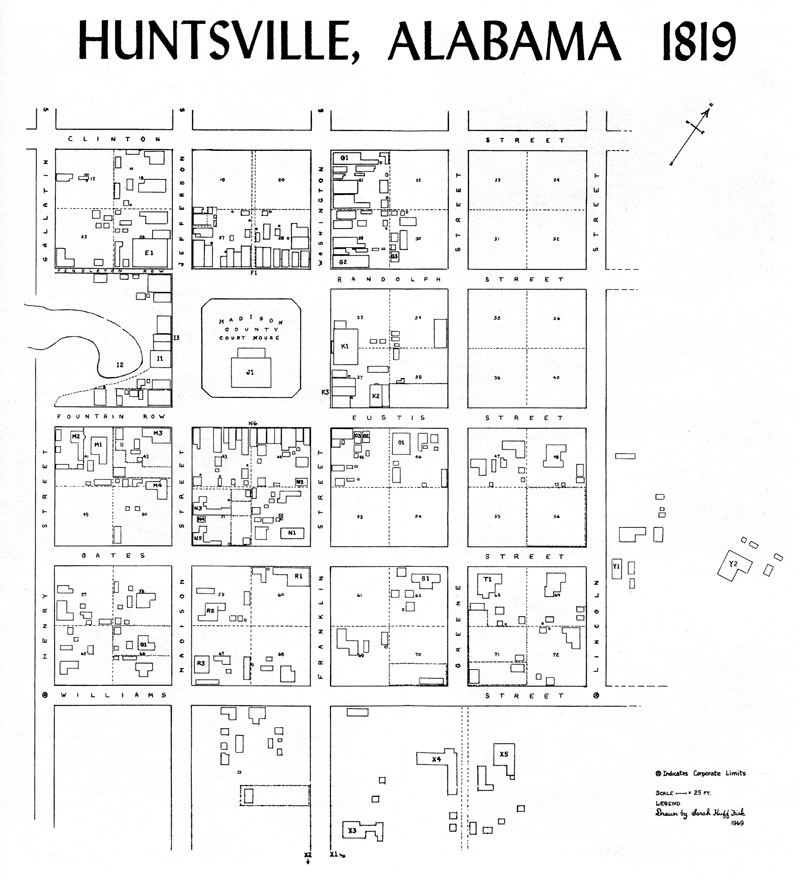

Among Buildings and Sites on Map, Following Are Specially Noted
E1 - Bell Tavern, a large two-story inn, known as Cheatham's Tavern, 1816-17, Turner's Tavern, 1818.
F1 - Northwest Side of Square, called "Cheapsides." Here, in 1819, were located three tailors, a bakery, two druggists, barber shop, silversmith, soap and candle maker, two attorneys, and five general stores.
G1 - Vaughn's House for Accommodation of Travelers.
G2 - Store and dwelling of Henry Cook, merchant, cotton factor, and Clerk of the Corporation.
G3 - Blacksmith Shop of Jared I. Sample.
I1 - Planters and Merchants Bank of Huntsville, first bank in Alabama, chartered December 11, 1816 by Mississippi Territorial Legislature. Two-story brick building.
I2 - The Big Spring, valuable source of pure water.
I3 - "Bank Row," described stores along Spring Bluff.
J1 - Madison County's First Courthouse, a two-story brick building, faced southeast. Alabama's First Legislative Assembly held many sessions here. In downstairs courtroom, on November 9, 1819, William Wyatt Bibb was inaugurated as first Governor of Alabama. Religious services were held in the courthouse.
K1 - Huntsville Inn, a three-story brick structure, built before 1817. A public dinner here, June 2, 1819, honored President James Monroe. First Alabama Legislature convened in this inn on October 25, 1819.
K2 - Huntsville Land Office, where U, S. Government sold thousands of acres of land in North Alabama.
K3 - "Brick Row" housed four of Huntsville's 31, or more, merchants. Stocks carried were often elaborate.
M1 - John Bunch's "Old Tavern," built before 1810.
M2 - Two-story log cabin, occupied by Hugh McVay in 1817.
M3 - Allen Cooper's Boarding House, two-story brick house built by John Read before 1815.
M4 - Home of Dr. David Moore, planter, civic leader, Surgeon General under Jackson in Creek Indian War.
N1 - Constitution Hall. The Convention met here on July 5, 1819 to organize the State of Alabama. The Constitution was signed on August 3, 1819 by 44 delegates from 22 counties of the Alabama Territory. Building used as a theater and assembly hall in 1819.
N2 - Clement Comer Clay's Law Office, erected before 1816, brick construction. Housed U. S. Government Surveyor's office and Huntsville Post Office, 1819.
N3 - Newspaper office and printing shop of "Alabama Republican," John Boardman, editor and publisher. On August 3, 1819, this weekly paper issued first complete printing of the Constitution. Laws passed by the 1819 Legislature were also printed here.
N4 - Huntsville Library, first in Alabama, organized October, 1818, incorporated November 27, 1819. Opened here on October 29, 1819 in law office of John N. S. Jones.
N5 - Home of Stephen Neal, Sheriff of Madison County.
N6 - Commercial Row, facing Square on southeast, was town's busiest block in 1819, with 13 general stores. Several buildings had two stories, eight were brick.
O1 - Young Ladies Academy, Joab Watson, Preceptor. Advertised opening date June 8, 1818, L. Morgan's white framed house, capacity over sixty students.
O2 - Dr. Alexander Erskine and Dr. Edmund Irby. At least a dozen physicians practiced in Huntsville, 1819.
O3 - Book Store and Auction House of A. D. Veitch.
Q1 - Bake House, James and William Badlun.
R1 - J. S. Rawling's Tavern, large white framed house. In 1820, this inn was known as "Planter's Hotel."
R2 - Home of Stokely Hutchings, first Postmaster.
R3 - Public House, operated by William E. Phillips.
S1 - Brahan-Goldsmith Home. Built 1818. Phillip A. Foote, merchant, occupied house, 1819. Gen. John Brahan resided here in 1820's.
T1 - Weeden-Stockton Home. Built in 1818 by Henry Bradford, merchant, who occupied it in 1819. Noted as home of Miss Howard Weeden, Huntsville's artist-poet, 1847-1905.
X1 - Fearn-Richardson Home. Site of house (not on map) purchased by Dr. Thomas Feam, 1819. House completed, 1820. Fearn was physician and surgeon who pioneered in use of quinine.
X2 - Bassett-Young Home, built 1819-1823 by Samuel Cruse, merchant. This house (not on map, but see photograph) has been property of Dr. John Young Bassett or his descendants since 1828.
X3 - Home of John Read, Register of the Land Office.
X4 - Home of Henry Minor, one of Madison County's eight delegates to the 1819 Convention.
X5 - Home of John M. Taylor, one of Madison County's delegates to 1819 Convention. Purchased in 1821 by Gov. Thomas Bibb, who built present mansion in 1837.
Y1 - Perkins-Orgain Home, built prior to 1816 by Col. Peter Perkins, first Clerk Madison County Superior Court, 1810. House owned by Arthur F. Hopkins, 1819, occupied by Clement Comer Clay.
Y2 - Pope-Watts Home, built prior to 1815, by LeRoy Pope, original purchaser of acreage on which town was laid out in 1810. By 1819, Pope could look from his mansion on the bluff across the thriving city of Huntsville, temporary capital of the new State of Alabama.
Map shows buildings known to have existed in 1819 on 56 of original 72 lots, also in area south and east of the corporate limits. Future research may establish location of other buildings.
Research Committee: Mrs. Burke S. Fisk, chairman, Mr. and Mrs. Donald H. Shenk, Mrs. W. F. Sparkman, Mrs. Wayne L. Smith, Mrs. J. T. Deaton.
Published by Huntsville Historical Society.